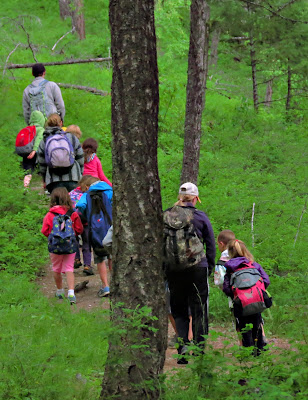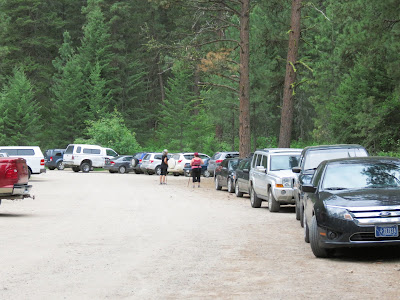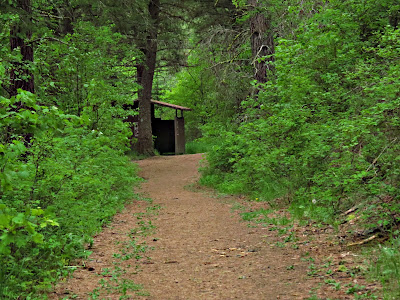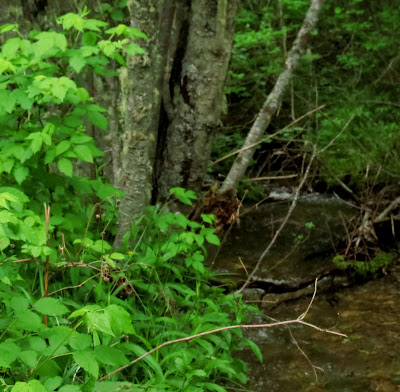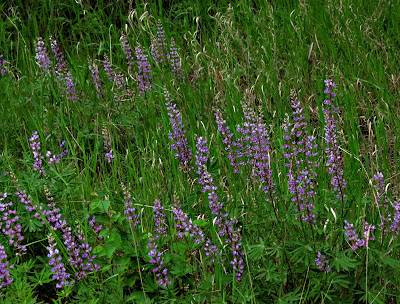I failed twice to get a prescription filled without making a personal trip to Missoula, so I planned a trip there for Friday. A new friend recommended some places to visit in the area. The one that seemed the most interesting for birding was a place called
Kelly Island Fishing Access on the Clark Fork River.
My GPS couldn't find it, so I tried using 7th street in Missoula as a point. This made me end up in the next town past Missoula. I regrouped, re-read my directions and tried using Mullan Road. This plus stopping to ask for directions eventually worked. After I got home, I looked it up on line and found there are two more ways to access the area - and think will give access to more territory. I'll have to go back because this was a really productive site.
I started the trip with a lifer - a red-naped sapsucker. What a brilliant guy. But he was not in a good location for me to get a full picture of him. And I hadn't even crossed the bridge that leads into the area yet. A blue-winged teal flew by.
 |
| Red-naped sapsucker |
I stepped over the chain preventing car access and started across the bridge. Then I heard a chickadee. I was able to get pictures of him both at the start and end of my trip. The couple of trees/shrubs held Bullocks oriole, cedar waxwings, Eastern Kingbirds, brown-headed cowbirds, robins, a kingfisher, and probably several birds that I didn't ever get clear views of.
 |
| Actively foraging black-capped chickadee |
 |
| Brown-headed cowbird |
 |
| Female Bullock's oriole |
 |
| One of four cedar waxwingsI saw - all in pairs. |
I finally tore myself away from the area around a little creek and started walking through a meadow. Two ospreys flew overhead while I walked through the meadow to the trees. My plan was to walk east until I got to the trees along the stream, then turn and follow the curve to the south and west. I was soon forcibly reminded of mosquitoes - haven't seen any since I've been here. I think I provided about a cup of blood to the food network. So I brushed mosquitoes off in groups while watching starlings, magpies, red-winged blackbirds and other species flying overhead. Tree swallows flew or perched in dead trees.Two birds that flew in to the dead tree turned out to be cedar waxwings.
 |
| The creek I found where I expected the river |
When I reached the shrubs, I found I was walking by a little creek that was full, fast, and loud. There were a few little birds feeding but I couldn't get good looks at them, due to dim light, and their fast movements. So I moved out from under the thick shrubs and walked so the sun would be behind me, to help see the birds I could hear. A bright yellow flash caught my eye - it turned to be a female yellow warbler who mostly moved fast through the bushes catching insects. I caught lots of glimpses of singing catbirds - and heard many more. In the same area, I caught the flutter of a male American Redstart but could only get mediocre pictures of him as he fluttered through the branches in search of insects.
 |
| Female yellow warbler |
 |
| American Redstart |
Right after I saw the redstart, I worked my way down to the intersection of this creek with the Clark Fork River and watched lots of birds flying over, including blackbirds, and Eurasian starlings carrying food and Eastern Kingbirds catching insects. Then a lone duck swam back and forth across the inlet to the creek. It was a common merganser.
 |
| View from almost the end of the second creek |
 |
| Common Merganser |
|
I had to stop and admire some cute little blue and yellow flowers which, I think, are American speedwell. Then I walked as far west as I could and admired the conjunction of the western stream and the river. This was the one I had walked over on a bridge at the entrance to the area. A movement caught my eye. It was a mother mallard and several ducklings swimming close to the far bank. I had my camera set to find faraway birds and couldn't get the entire group in the picture but I think she had six or seven ducklings. An "auntie" bird - or at least another female, was at the back of the scraggly line. Then I caught the flash of a bird landing and looked way up the hill to see a flicker sitting in a pine tree.
 |
| American speedwell |
 |
| Momma Mallard and some of her half-grown ducklings |
 |
| A flicker watched over the duckling scene from way up the hill |
I finished walking back to the bridge but had to stay there a while to enjoy the birds. Then the bison in the adjoining field start acting up and a pair challenged each other. Another bull joined in and there were three of them chasing each other. The second one was the main aggressor and the third one just seemed to be enjoying running after the first two.
 |
| Bison confrontation |
 |
| Chasing through the creek |
And just as I left the area, I had to stop and take a yard full of alpacas. The yard had to be less than half an acre, but had more alpacas than fit in my picture. Pretty amazing in a neighborhood.
And that was just my early morning adventure. After running a few errands, I went on a hike in the Rattlesnake Creek Recreation Area. I'll tell you about that next time.



















